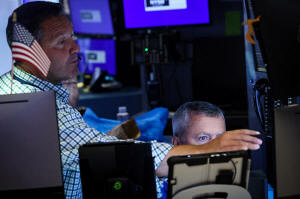Wall St ends volatile session lower in aftermath of global tech outage
 Send a link to a friend
Send a link to a friend
 [July 20, 2024] By
Stephen Culp [July 20, 2024] By
Stephen Culp
NEW YORK (Reuters) -U.S. stocks extended their slump on Friday as
lingering chaos related to a global technical outage caused by a
software glitch added uncertainty to an already-anxious market.
The far-reaching tech outage disrupted operations across multiple
industries including airlines, banking and healthcare after the glitch
in cybersecurity firm Crowdstrike's software caused Microsoft's Windows
operating system to crash.
While the flaw was identified and fixes deployed, technical issues
continue to affect some services.
Crowdstrike shares slid 11.1%, while rival cybersecurity firms Palo Alto
Networks and SentinelOne advanced 2.2% and 7.8%, respectively.
All three major U.S. stock indexes ended in negative territory, with the
Dow Jones Industrial average suffering the worst of it.
On a weekly basis, both the Nasdaq and the S&P 500 logged their worst
week since April, while the Dow, having reached a series of all-time
closing highs earlier in the week, posted a Friday-to-Friday gain.
"This tech outage adds some uncertainty and puts pressure on the overall
Nasdaq," said Robert Pavlik, senior portfolio manager at Dakota Wealth
in Fairfield, Connecticut. "But it won’t have much of an overall impact.
Some buying will be delayed. Not only is it a summer Friday but because
of the outage (investors) are in wait-and-see mode."

"They're sitting on the sidelines," Pavlik added. "That's what happens
to the stock market when volatility rules the day."
The CBOE Market volatility index, considered a gauge of investor
anxiety, touched its highest level since late April.
The smallcap Russell 2000 - a beneficiary of a recent pivot away from
megacap growth stocks - ended modestly lower.
Nvidia shares led a sell-off in chips. The Philadelphia SE Semiconductor
index underperformed the broader market, falling 3.1%.
Elsewhere, Federal Reserve Bank of New York President John Williams
reiterated the central bank's commitment to bringing inflation down to
its 2% target.
Financial markets have priced in a 93.5% likelihood that the Fed will
enter a rate-cutting phase at the conclusion of its September meeting,
according to CME's FedWatch tool.
The Dow Jones Industrial Average fell 377.49 points, or 0.93%, to
40,287.53, the S&P 500 lost 39.59 points, or 0.71%, to 5,505 and the
Nasdaq Composite dropped 144.28 points, or 0.81%, to 17,726.94.
[to top of second column] |

Traders work on the floor at the New York Stock Exchange (NYSE) in
New York City, U.S., July 3, 2024. REUTERS/Brendan McDermid/File
photo

Among the 11 major sectors of the S&P 500, energy shares fell the
most, while healthcare and utilities were the only gainers.
Second-quarter earnings season ended its first full week, with 70 of
the companies in the S&P 500 having reported. Of those, 83% have
beaten consensus, according to LSEG.
Analysts now see aggregate year-on-year S&P 500 earnings growth of
11.1%, an improvement over the 10.6% estimate as of July 1.
Next week, a swath of high-profile results is expected from Tesla,
Alphabet, IBM, General Motors, Ford and a host of other companies.
"It's early in earns season, but things have been impressive," said
Ryan Detrick, chief market strategist at Carson Group in Omaha,
Nebraska. "But the big boys are starting to report next week and
what we want to hear is how strong the consumer is and what's the
outlook for future economic growth."
Eli Lilly advanced 1.0% after China approved its weight-loss drug
tirzepatide, while Intuitive Surgical jumped 9.4% after a
second-quarter results beat.
Travelers tumbled 7.8% on lower-than-expected growth in net written
premiums.
Netflix fell 1.5% in choppy trading after the streaming giant
cautioned third-quarter subscriber additions would be lower than a
year earlier.
Oilfield services provider SLB rose 1.9% after strong second-quarter
profit.
Declining issues outnumbered advancing ones on the NYSE by a
2.11-to-1 ratio; on Nasdaq, a 1.91-to-1 ratio favored decliners.
The S&P 500 posted 27 new 52-week highs and 4 new lows; the Nasdaq
Composite recorded 50 new highs and 99 new lows.
Volume on U.S. exchanges was 10.54 billion shares, compared with the
11.72 billion average for the full session over the last 20 trading
days.
(Reporting by Stephen Culp in New YorkAdditional reporting by Lisa
Pauline Mattackal and Ankika Biswas in BengaluruEditing by Devika
Syamnath and Matthew Lewis)
[© 2024 Thomson Reuters. All rights
reserved.]
This material may not be published,
broadcast, rewritten or redistributed.
Thompson Reuters is solely responsible for this content.
 |